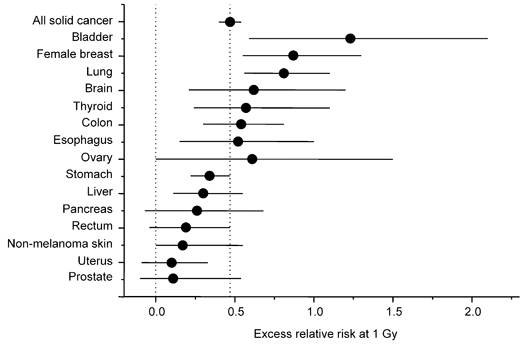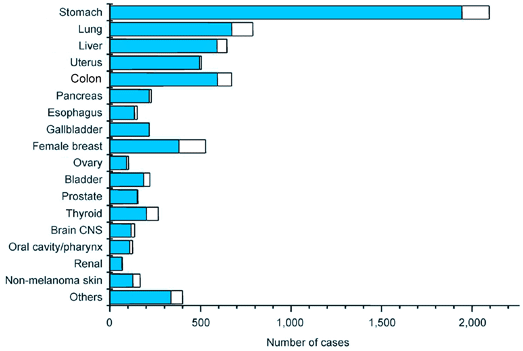Site-specific Cancer Risks among Atomic-bomb Survivors
Significant excess risks are seen for many of the major types of solid cancer, including cancers of the stomach, lung, liver, colon, bladder, breast, ovary, thyroid, and skin. Although not always statistically significant, excess risks are also seen for most other types of cancer. Thus, the survivor data are consistent with the notion that radiation is associated with excess risks for virtually all cancers. Since site-specific risks can differ by sex and age at exposure, Figure 1 adjusts for such differences and compares risks among sites by presenting sex-averaged data showing the risk at age 70 after exposure at 30 years of age. Under these conditions, the excess relative risk value (ERR) for all solid cancers combined is 47% following exposure to 1 Gy. While differences in site-specific risks are apparent, the range of variation is not statistically significant, partly because the numbers of cancer cases at given sites are limited.

Figure 1. Excess relative risk per Gy for the incidence of site-specific cancers in the LSS cohort. The risk is standardized as exposure at 30 years of age (sex-averaged) and diagnosed at age 70. The horizontal bars indicate 90% confidence intervals.
Figure 2 presents similar site-specific data in terms of attributable risk (i.e., what percent of total cases are associated with radiation). The largest excess number of cases (given in parentheses) were for cancers of the stomach (150), female breast (147), lung (117), colon (78), thyroid (63), and liver (54).

Figure 2. Number of site-specific cancer cases occurring in the exposed group (≥0.005 Gy), 1958-1998. The white portion indicates excess cases associated with radiation.
Analyses of site-specific cancer incidence data are often superior to those of cancer mortality studies. This is because incidence studies provide better diagnostic information and are better able to assess the occurrence of less fatal cancers, such as thyroid and skin. For all solid cancers combined, the excess relative risks were comparable for incidence (47% excess per Gy) and mortality (42%), but the excess absolute risk was 1.9 times greater (52 versus 27 excess cases per 10,000 person-years per Gy, respectively).

